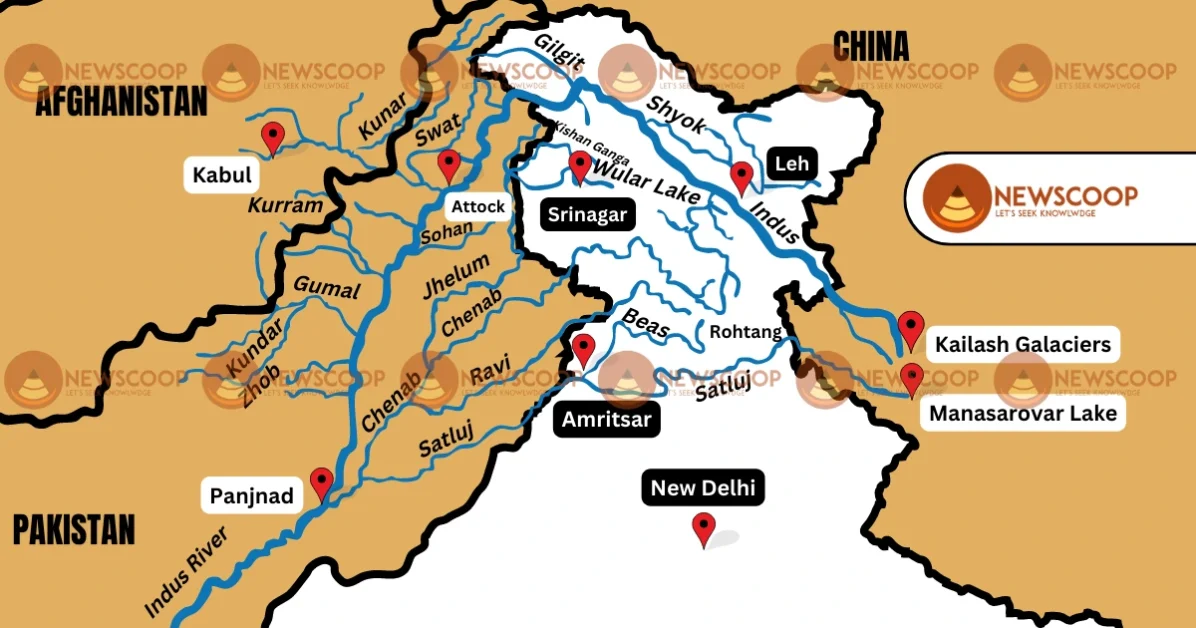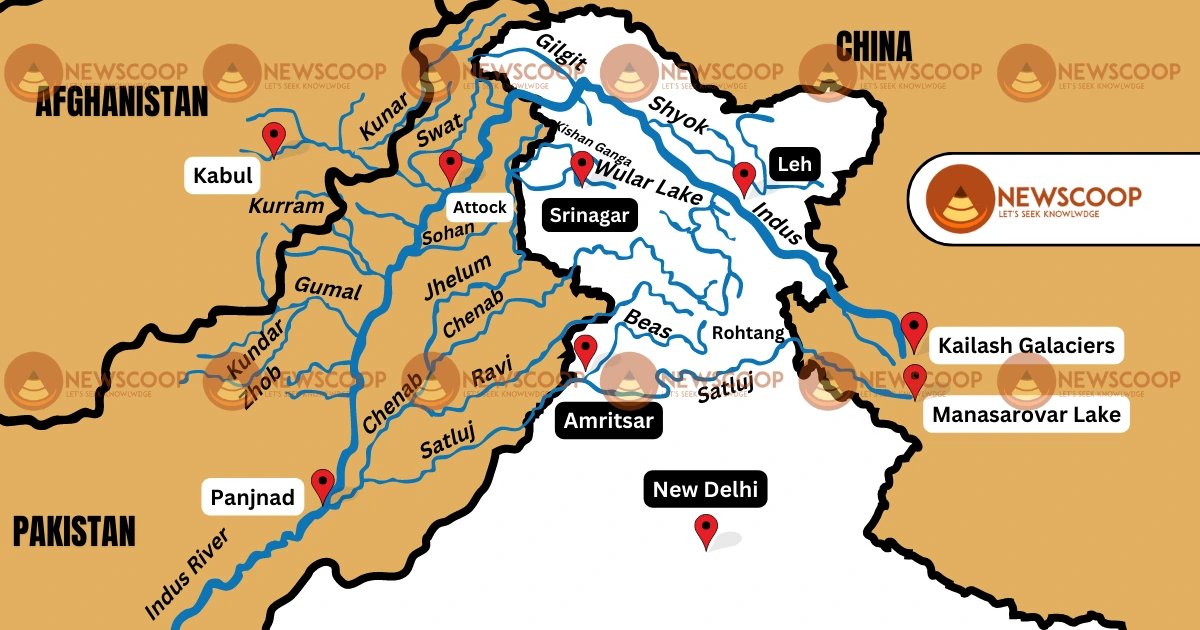Five Rivers of Punjab: Map of India & Names
Punjab, the land of five rivers, holds a unique distinction in India for its rich geographical and cultural heritage. The rivers Chenab, Jhelum, Ravi, Beas, and Satluj collectively known as the “Five Rivers of Punjab,” have been the lifeblood of the region for centuries.
In this post, we will explore the key features and significance of each river, highlighting their crucial roles in shaping Punjab’s identity and providing sustenance to its people.
| River Name | Source |
|---|---|
| Jhelum | Kashmir |
| Chenab | Jammu & Kashmir |
| Ravi | Himachal Pradesh |
| Beas | Himachal Pradesh |
| Sutlej | Tibet |
Five Rivers of Punjab
The following are the names of the five rivers of Punjab:
- Chenab
- Jhelum
- Ravi
- Beas
- Satluj

Chenab River
- Origin: Himalayas in Jammu and Kashmir, India.
- Course: Flows through Jammu and Kashmir and enters the plains of Punjab, India.
- Significance: Crucial for irrigation and water supply in the region.
- Geographical Features: Carves through deep gorges, creating breathtaking canyons.
Click For More Information: Chenab River
Jhelum River
- Origin: Glaciers in Indian-administered Kashmir.
- Course: Flows through the northern part of Punjab, India, before entering Pakistan.
- Significance: Contributes to agriculture and sustains ecosystems.
- Historical Importance: Witnessed important events and battles in ancient times.
- Geographical Features: Features lush green valleys and fertile plains.
Ravi River
- Origin: Himalayas in Himachal Pradesh, India.
- Course: Flows through the northwestern part of Punjab, India, before entering Pakistan.
- Significance: Supports agriculture and irrigation in the region.
- Cultural Importance: Once marked the eastern boundary of Alexander the Great’s conquest.
- Geographical Features: Picturesque landscapes and serene surroundings.
Click For More Information: Ravi River
Beas River
- Origin: Beas Kund in Himachal Pradesh, India.
- Course: Flows through the picturesque valleys of the region.
- Significance: Provides water for irrigation and hydropower projects.
- Geographical Features: Boasts snow-capped peaks, verdant meadows, and scenic landscapes.
- Adventure: Attracts tourists for adventure sports and nature experiences.
For More Information: Beas River
Satluj River
- Origin: Tibet.
- Course: Flows through Himachal Pradesh and Punjab, India.
- Significance: Used for hydropower generation and irrigation.
- Geographical Features: Encompasses mountainous terrain and lush valleys.
For More Information: Satluj River
List of Dams
Here is a list of major dams in Punjab along with the respective rivers they are associated with:
- Bhakra Dam – River Sutlej
- Pong Dam (Maharana Pratap Sagar) – River Beas
- Ranjit Sagar Dam (Thein Dam) – River Ravi
- Harike Barrage – River Sutlej and Beas (confluence point)
- Shah Nahar Barrage (Firozpur Barrage) – River Sutlej
- Ropar (Rupnagar) Barrage – River Sutlej
- Hussainiwala Barrage – River Sutlej
- Mukerian Hydel Project (Shanan Power House) – River Beas
- Anandpur Sahib Hydel Channel – River Sutlej
- Bhakra Nangal Tail Channel – River Sutlej
- Pandoh Dam – River Beas
Importance of Punjab Rivers
The “Five Rivers of Punjab,” comprising the Ravi, Chenab, Jhelum, Satluj, and Beas rivers, hold immense importance for the region and its people. Here are the key reasons why these rivers are vital to Punjab:
- Agricultural Support: The rivers are the lifeline of Punjab’s agriculture. The fertile alluvial soil in the river basins, along with ample water supply, makes the region one of India’s most productive agricultural zones. These rivers facilitate irrigation, enabling farmers to cultivate a variety of crops, including wheat, rice, cotton, and sugarcane.
- Water Supply: Punjab heavily relies on these rivers for its water needs. They provide essential freshwater for drinking, household purposes, and industries, ensuring the well-being and economic development of the state’s population.
- Hydropower Generation: The rivers have been harnessed for hydroelectric power generation. Numerous dams and hydropower projects have been built along their courses, providing a significant source of renewable energy for Punjab and neighboring regions.
- Transportation and Trade: Historically, these rivers were crucial trade routes, facilitating the transportation of goods and fostering economic exchanges between different regions. Although less significant as trade routes today, they still support river transport for certain commodities.
- Tourism and Recreation: The scenic beauty of these rivers attracts tourists and nature enthusiasts. The rivers offer opportunities for boating, fishing, and other recreational activities, contributing to the tourism industry in the region.
- Cultural and Historical Significance: The rivers hold cultural and historical importance. They have been mentioned in ancient texts and played roles in various historical events and military campaigns, adding to the cultural heritage of Punjab.
- Biodiversity and Ecosystem: The rivers and their surrounding ecosystems support diverse flora and fauna. Wetlands, marshes, and riverbanks provide habitats for numerous plant and animal species, contributing to the region’s biodiversity.
- Groundwater Recharge: Besides surface water, these rivers also contribute to groundwater recharge, ensuring a sustainable water supply for the region.
- Flood Control: The rivers help in managing and controlling floods during heavy monsoons, protecting lives and property from potential damage.
Overall, the “Five Rivers of Punjab” are not only essential for the state’s economic and agricultural activities but also hold cultural, historical, and environmental significance. They are an integral part of Punjab’s identity and play a vital role in the region’s prosperity and well-being.
Also read: Rivers of Gujarat
Conclusion
The “Five Rivers of Punjab” – Ravi, Chenab, Jhelum, Satluj, and Beas – are not only integral to the region’s cultural heritage but also play vital roles in supporting agriculture, hydropower generation, and tourism.
Their geographical features, ranging from serene surroundings to deep gorges and lush valleys, make them diverse and captivating waterways. Each river contributes uniquely to Punjab’s identity and prosperity, emphasizing the enduring connection between nature and human civilization.
Thank You!
What are the five rivers of Punjab?
The five rivers that flow through the region of Punjab, collectively known as the “Five Rivers of Punjab,” are the Beas, Chenab, Jhelum, Ravi, and Sutlej.
Where do 5 rivers meet in Punjab?
The confluence of the five rivers, known as “Punjab” which means “Land of Five Rivers,” occurs in Pakistan, near the city of Multan.
What region is often referred to as the ‘Land of Five Rivers’?
The region that is often referred to as the “Land of Five Rivers” is Punjab.

